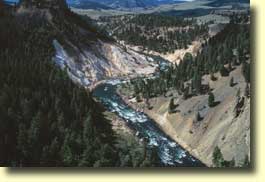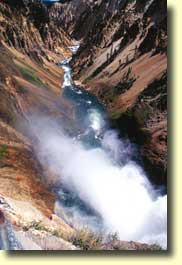Yellowstone Grand Canyon
Russian
Yellowstone Grand Canyon |
Russian |
This area of the park opens the most dramatic views of Yellowstone. Canyon has its geological origins in the same gigantic eruption, which created Yellowstone Lake six hundred thousands years ago. Lava carved the canyon, which subsequently was blocked by glaciers. When all the ice melted, floods re-carved each end of the canyon, deepening it and removing sand and gravel. As a result of these combined forces of nature - the canyon is 20 miles long, 1200 feet deep, and 4000 feet wide, it has two waterfalls, one of which is twice as high as Niagara falls.
Yellowstone River, which name gave the name to the whole park, begins its 671-mile journey to the Missouri in the southern mountains of the park. |
 |
|
Grand Canyon of Yellowstone |
In its current look canyon was created only fourteen thousand years ago, after all glaciers melted. Several viewpoints along the canyon allow nowadays to enjoy the dramatic scenery (though some of them are not very easy to rich). If you follow the map direction and go from through all (or most) of the observation decks from Inspiration point to the Artist point, then every subsequent trail opens more an more interesting side of the canyon.

View of the canyon from the brinks of the Lower Falls viewpoint
All the previous viewpoints were "arranged" on the trail as if coming to more and more interesting views. But this one - the view of Upper Falls, does not fall to this line. And it is too bad - maybe the Upper Falls should have been put before the Lower Falls, to make sure that it is appreciated as well as it deserves to be. Upper Halls (109 feet) is impressive in its own way, but because it is located on the turn on the river it did not get such good viewpoints, as Lower Falls.
[Back to album | Back to photography | Back to front page]
Last updated: Tuesday, October 23, 2001